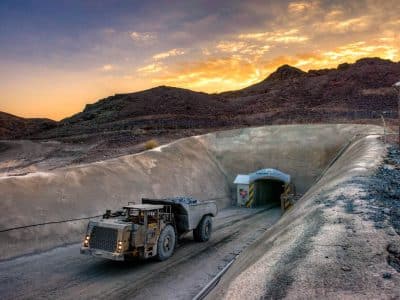An artificial island in the shape of a palm tree, Palm Jumeirah increased Dubai’s shoreline dramatically, as well as creating a world-class platform for hotels, resorts and villas. The entire project was to have been capped off by the Trump International Hotel & Tower on the trunk, a 62-storey mixed-use project on the Golden Mile.
First announced in 2005, Nakheel announced in 2009 that work had been suspended indefinitely. This sentiment was echoed later by Donald Trump Jnr., who stated that construction on the billion-dollar project would not happen “any time soon”.
Despite the bursting of the real-estate bubble and the myriad troubles that embroiled master developer Nakheel, the Palm Jumeirah remains a stunning engineering feat. The crescent is constructed from rock, while all the frond-like islands contained within are (literally) built on sand.
The breakwater stands in 10.5m of open ocean at its deepest point, rising to 4m above chart datum, or sea level at low tide. The breakwater was designed to protect the Palm Jumeirah against worst-possible sea conditions, including once-in-a-century Shamal-induced storm events, and even global warming.
Sand, covered by an erosion-preventing water-permeable geotextile, comprises the breakwater’s lowest layer. One-ton rocks cover the sand, with two layers of large rocks, weighing up to six tons each, capping the structure. A ‘toe’, placed by a floating crane, sits inside the crescent. The breakwater also has two 100m openings on each side to eliminate stagnation in the channels. These gaps allow water to recirculate every 13 days.
With the crescent in palce, 4.8m cubic metres of rock were positioned to create the land foundations of the inner frond-like islands. Ten dredgers then began working around the clock to transfer an astonishing 92.234m cubic metres of sand to build up the required land mass.
One of the latest developments at Palm Jumeirah is master developer Nakheel issuing a tender for infrastructure works on Frond ‘N’. It has invited suitably-qualified contractors, licensed by Dubai’s Department of Economic Development, to bid for Tender No. N-006-4-60.
The project comprises: roads, parking, driveways and sidewalks; street lighting, stormwater drainage network; vacuum sewerage; ancillary control and monitoring system; irrigation water system and fire hydrants; utility road crossings: potable water system, electrical network; telecoms network and LPG gas house connections. The closing date for bids from interested contractors is 4 March.
Nakheel has also announced plans to build an exclusive new $80m restaurant and shopping area at the tip of its Palm Jumeirah development in Dubai. The Pointe will be constructed at the tip of the Palm Jumeirah’s trunk, facing the Atlantis hotel. It will cover 131,000m2 and include 56,120m2 of high-end retail shops, a combination of informal and formal dining, a 34,130m2 promenade, a marina with floating pontoons and a computerised water fountain set offshore.
The Pointe will also have 1,200 parking spaces and be linked to the Palm Jumeirah monorail system. Water taxis will also operate between the Palm Atlantis and the Pointe, while the marina will allow boat owners to moor nearby and visit the development. Initial designs for the project have already been produced by Dar Al Handasah, with plans allocating space for 75 retail shops and 120 cafes and restaurants.
Nakheel chairman Ali Rashid Lootah told reporters that tenders for work on the project would be announced within the next two months, and that work would begin on-site by mid-year. He said construction would take 18 months, and that The Pointe would be ready to open at the end of 2013.
“We will see,” Lootah said when asked whether 18 months was a realistic timeframe. “It is a relatively straightforward plan, and contractors need the work. If you pay contractors, they will do the work – and we have gone to great lengths to ensure we have paid everyone,” said Lootah.
Article continued on next page…
Meanwhile, in a further attempt to publicise both the achievements and ongoing activities of the beleaguered master developer, Nakheel’s MD of marine and leisure has hailed a new cruise facility to see “inside the heart” of the Palm Jumeirah and the World Islands as a “new perspective for tourists, residents and citizens of Dubai.”
Saeed Harib announced that boat tours, under the name ‘Cruise with Nakheel’, would be initiated for members of the public wanting to catch a glimpse of the likes of the world-famous Atlantis Hotel from the clear blue inner waters of Palm Jumeirah’s crescent. Cruisers will sail north between the tips of the island’s fronds and its 11.5km long crescent, home to a number of luxury hotels and resorts. “Cruise with Nakheel is a completely new concept for marine tourism,” said Harib. “Travellers can now go ‘inside’ Palm Jumeirah and enjoy views of the island and its buildings as never before.
“The Palm is already one of Dubai’s biggest attractions, and we look forward to bringing more visitors to this world-famous landmark through our new cruise service.” Asked whether Nakheel should concentrate on completing unfinished developments on land before starting new ones at sea, Harib countered by saying that they “did not compare. Past projects were land, and this is water. Palm Jumeirah is almost finished, and now we start developing water projects.
“Where we are is the heart of the Palm. We have a lot of visitors to Dubai. They know about Burj Khalifa, Burj Al Arab, the World and the Palm Jumeirah, but they do not get to ‘feel’ the Palm. So we launched a new project. We are very excited about bringing people to the heart of the Palm. It is an important project to add to the Nakheel portfolio.”
Rixos The Palm
Part of a Turkish luxury hotel group, the Rixos The Palm is a 234-key, five-star development that is home to a traditional Turkish ‘hammam’ or bath, a luxury spa, four restaurants, meeting rooms and a private beach. The launch of this hotel is a statement of intent for the Turkish hospitality group, which intends to use it as a platform to break into the UAE market and then into the wider GCC.
The mechanical, electrical and plumbing work for the Rixos The Palm was undertaken by Turkish MEP giant AE Arma-Elektropanç. After the commencement of the project, the contractor was given the near impossible task of completing the project by 1 January, in conjunction with the main contractor, Sembol Construction Company.
AE Arma-Elektropanc business development manager Burak Kizilhan commented that, despite the extremely short timeframe, his team pulled together and managed to get the job done on time, with about 98% of the MEP work completed as of December 2011. “All of our projects have always made deadline,” added Kizilhan.
“We were confident of doing so, as we worked hard, seven days a week, with all the materials necessary on-site and around 800 workers.” Normally for a project of this size, no more than 250 to 300 workers would be required to complete it, provided the time-frame given for the overall project would accommodate the work that needed to be done, explained Mokhles Islam, mechanical coordinator for AE Arma-Elektropanç, and a supervisor on the project. That was not an option for this project, however, said Kizilhan, as AE Arma-Elektropanç was brought in at a very advanced stage of the development in order to complete the project.
“Usually you can handle this kind of project with 300 to 250 skilled people and manual labour, but we were in a situation where we assigned around 800 people. This included the required supervision teams and so on, but we managed to increase our productivity to three times the normal level,” said Islam.
Royal Amwaj
With a built-up area of 160,000m2 and a mix of duplex condos, sunken villas and water homes surrounding the world’s largest lagoon, construction on the Royal Amwaj, to be operated by Mövenpick, commenced in 2007. “At that time the tunnel was not ready. Transporting material and personnel was a problem. We had to use barges to transport concrete and workers, so it was a difficult process,” GTCC executive director Saleh Muradweij commented at the time.
Article continued on next page…
The design of the Royal Amwaj is based on the spa-style luxury resorts of Thailand, with wood featuring predominantly on the façades, floors and ceilings. However, local conditions had to be taken into account. “The way the roofs have been constructed is different. In Thailand, pitched concrete roofs with tiles are used. Here we have employed steel structures with polyurethane foam as insulation, waterproofing and then an overlay of clay tiles imported from Thailand,” said Muradweij. “There was a lot of development of the original design to suit the local climate.
Habtoor Grand Palm Resort & Spa
The first Waldorf Astoria resort is set to open in Dubai following a deal between local conglomerate Al Habtoor Group and hospitality chain Hilton Worldwide. The planned $272m resort, being built by Al Habtoor, was suspended in the wake of the financial crisis and subsequent bursting of the real-estate bubble. However, the Dubai developer announced towards the end of last year it would restart construction work on the 330-room hotel, with the property to be managed under Hilton’s Waldorf Astoria brand.
“[I am] committed to participating [in Dubai real estate] and meeting my commitments by adding more projects, which we are going to announce soon,” said chairman Khalaf Al Habtoor. “This is funded from our own cash flow; it is not funded by any banks.” The launch will mean fresh competition for state-backed hotel resort Atlantis which, until recently, had benefited from being the Palm’s sole hotel since its opening three years ago. More than 30 themed resorts had been planned for the island before the onset of the global financial crash in late-2008, but were scaled back dramatically as project financing dried up.
Kempinski confirmed in March 2011 that it was mothballing its 253-room Emerald Palace project until at least 2013, citing oversupply in the market.
State-backed Jumeirah Group also announced in May 2011 that it would suspend its planned Jumeirah Al Fattan Palm Resort.
Hotels still due to open, apart from Rixos The Palm, are Mövenpick’s Oceana Resort, the Sofitel Spa resort, the Habtoor Island Resort and Spa and Hilton. Branded properties One & Only The Palm and Jumeirah Zabeel Saray opened in 2011.
Taj Exotica
ETA Star, the real-estate arm of the ETA Star-Ascon Group, plans to open the 232-key Taj Exotica Resort & Spa on the Palm Jumeirah in Q4 2012, in addition to the handover of the Grandeur Residences. “We have not stopped construction on Taj Exotica, albeit it is slow,” said ETA Star executive director Abid A. Junaid
The original opening date was 2010, with the project launched in 2006. It is modelled on the archetypal palaces of Rajasthan, with the Jiva Spa set to be the largest in the Middle East. The Grandeur Residences comprise 220 fully-furnished one-, two- and three-bedroom apartments, in addition to ten beachfront villas.








